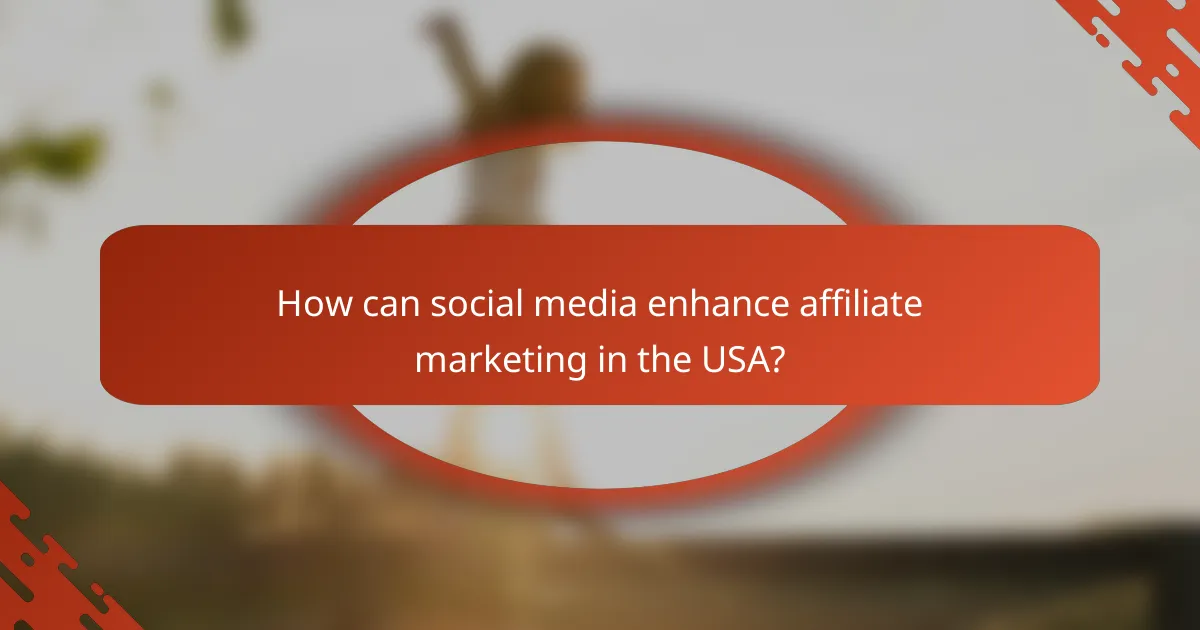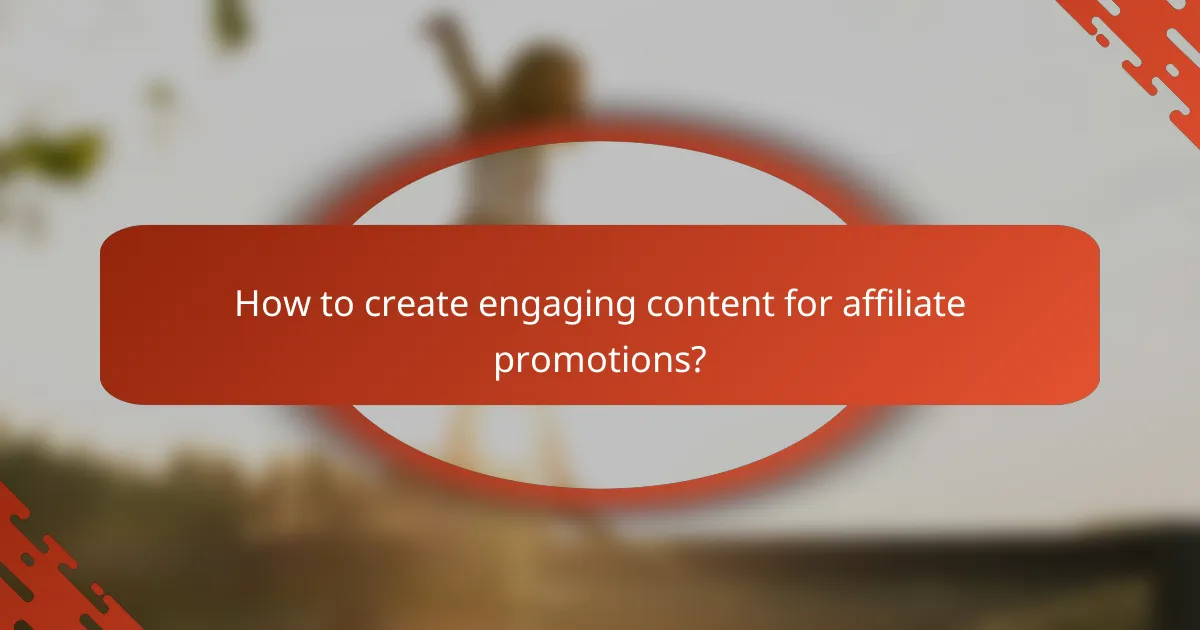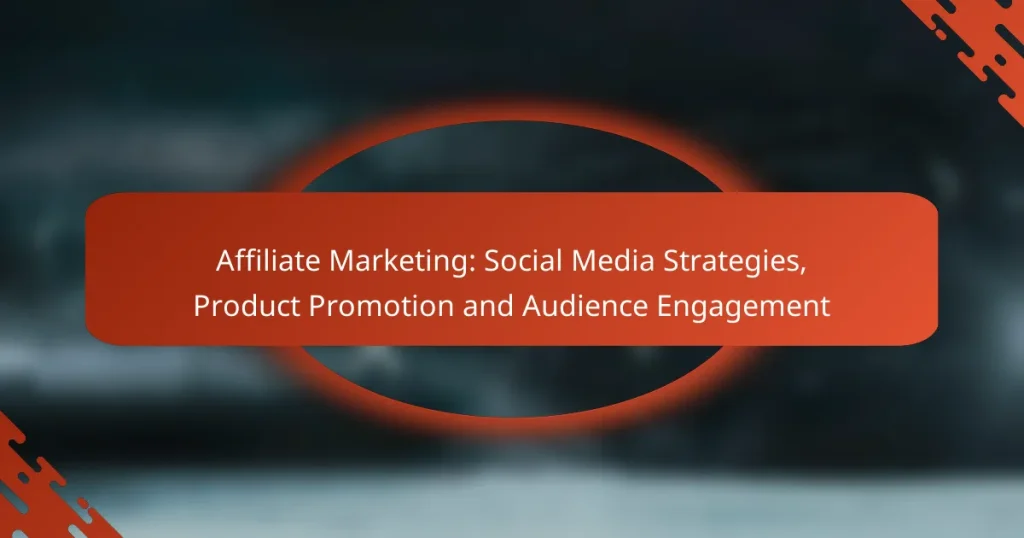Affiliate marketing thrives on social media by broadening audience reach and enhancing engagement through targeted advertising. Platforms like Instagram, Facebook, Twitter, and LinkedIn each provide unique opportunities to connect with potential customers, making it crucial to select the right one for your marketing objectives. By crafting authentic and creative content, marketers can effectively promote products while fostering meaningful interactions with their audience.

How can social media enhance affiliate marketing in the USA?
Social media can significantly enhance affiliate marketing in the USA by expanding audience reach, improving engagement, and offering targeted advertising options. These platforms allow marketers to connect with potential customers in real-time, driving traffic and conversions effectively.
Increased audience reach
Social media platforms like Facebook, Instagram, and Twitter have millions of active users, providing a vast audience for affiliate marketers. By sharing content that resonates with users, marketers can tap into diverse demographics and geographic locations across the USA.
Utilizing hashtags, engaging visuals, and strategic posting times can further amplify reach. For example, a well-timed post during peak hours can increase visibility, leading to higher click-through rates on affiliate links.
Improved engagement rates
Engagement rates on social media are typically higher than traditional marketing channels, making it easier to foster relationships with potential customers. Interactive content such as polls, quizzes, and live videos can keep audiences engaged and encourage them to share content.
Marketers should focus on creating valuable content that sparks conversations. Responding to comments and messages promptly can enhance trust and loyalty, which are crucial for successful affiliate marketing.
Targeted advertising options
Social media platforms offer sophisticated targeting options that allow affiliate marketers to reach specific audiences based on interests, behaviors, and demographics. This precision helps in crafting tailored messages that resonate with potential buyers.
For instance, Facebook Ads can target users by age, location, and interests, ensuring that affiliate promotions reach the most relevant audience. Setting a budget and testing different ad formats can optimize campaign performance and return on investment.
Real-time feedback and analytics
Social media provides real-time feedback through likes, shares, and comments, allowing marketers to gauge audience reactions instantly. Analytics tools available on platforms like Instagram and Twitter can track engagement metrics, helping to refine strategies.
Marketers should regularly review these analytics to identify what content performs best. Adjusting strategies based on this data can lead to improved campaign effectiveness and higher conversion rates.
Brand partnership opportunities
Social media facilitates connections between affiliate marketers and brands, opening doors for collaboration. Influencer partnerships can enhance credibility and reach, as influencers often have dedicated followers who trust their recommendations.
Marketers should seek out brands that align with their audience’s interests for mutually beneficial partnerships. Clear communication about expectations and compensation can lead to successful collaborations that drive affiliate sales.

What are effective social media platforms for affiliate marketing?
Effective social media platforms for affiliate marketing include Instagram, Facebook, Twitter, and LinkedIn. Each platform offers unique features that cater to different audiences and types of products, making it essential to choose the right one based on your marketing goals.
Instagram for visual products
Instagram is ideal for promoting visually appealing products, such as fashion, beauty, and home decor. The platform’s focus on images and videos allows affiliates to showcase products in an engaging way, often leading to higher conversion rates.
Utilize Instagram Stories and Reels to create short, captivating content that highlights product features and benefits. Incorporating user-generated content can also enhance authenticity and encourage audience engagement.
Facebook for community building
Facebook excels at fostering community engagement, making it suitable for affiliate marketers looking to build relationships with their audience. Creating dedicated groups or pages allows for direct interaction and sharing of valuable content related to your niche.
Consider using Facebook Live to host Q&A sessions or product demonstrations. This real-time interaction can increase trust and drive sales through affiliate links shared during the sessions.
Twitter for real-time promotions
Twitter is effective for real-time promotions and updates, making it a great platform for time-sensitive offers. The fast-paced nature of Twitter allows affiliates to quickly share deals and engage with followers through tweets and retweets.
Use relevant hashtags to increase visibility and join trending conversations related to your products. Keep tweets concise and include clear calls to action to encourage clicks on your affiliate links.
LinkedIn for B2B affiliate marketing
LinkedIn is the go-to platform for B2B affiliate marketing, focusing on professional networking and industry insights. Affiliates can promote products and services that cater to businesses, such as software solutions or professional development courses.
Share informative articles, case studies, and industry news to establish authority and attract a professional audience. Engaging with connections through comments and messages can also lead to valuable partnerships and sales opportunities.

How to create engaging content for affiliate promotions?
Creating engaging content for affiliate promotions involves delivering valuable information that resonates with your audience while effectively showcasing products. Focus on authenticity and creativity to capture attention and encourage interaction.
High-quality visuals and videos
Using high-quality visuals and videos is essential for grabbing attention in affiliate promotions. Clear images and well-produced videos can significantly enhance the appeal of your content, making it more likely to be shared and engaged with.
Consider using tools like Canva or Adobe Spark to create eye-catching graphics, and platforms like YouTube or TikTok for video content. Aim for a mix of product demonstrations, tutorials, and lifestyle shots that show the product in use.
Authentic storytelling
Authentic storytelling connects with audiences on a personal level, making your affiliate promotions more relatable. Share personal experiences or customer testimonials that highlight the benefits of the products you promote.
When crafting your narrative, focus on how the product solved a problem or improved a situation. This approach not only builds trust but also encourages your audience to envision themselves using the product.
Interactive polls and quizzes
Interactive polls and quizzes can significantly boost audience engagement in affiliate marketing. These tools invite participation and can provide valuable insights into your audience’s preferences and interests.
Use platforms like Instagram Stories or Facebook to create quick polls, or design quizzes that help users find the best product for their needs. This not only entertains but also drives traffic to your affiliate links.
Influencer collaborations
Collaborating with influencers can amplify your affiliate promotions by leveraging their established trust and audience. Choose influencers whose values align with your brand and who have a genuine connection with their followers.
When partnering with influencers, ensure they create authentic content that showcases the product naturally. This can include reviews, unboxings, or tutorials that resonate with their audience, driving more traffic to your affiliate links.

What metrics should be tracked for social media affiliate success?
To achieve success in social media affiliate marketing, it’s crucial to track key metrics that reflect performance and audience engagement. Focusing on click-through rates, conversion rates, engagement metrics, and return on investment will provide insights into the effectiveness of your strategies.
Click-through rates
Click-through rates (CTR) measure the percentage of users who click on your affiliate links compared to the total number of users who view your posts. A higher CTR indicates that your content is compelling and encourages action. Aim for a CTR of around 1-3% as a general benchmark, but this can vary by platform and audience.
To improve CTR, use clear calls to action, engaging visuals, and relevant hashtags. Regularly analyze which types of posts generate the most clicks and adjust your strategy accordingly.
Conversion rates
Conversion rates indicate the percentage of users who complete a desired action, such as making a purchase after clicking your affiliate link. A typical conversion rate for affiliate marketing ranges from 1-10%, depending on the product and audience. Tracking this metric helps you understand how effectively your content drives sales.
To enhance conversion rates, ensure that your landing pages are optimized for user experience, with clear messaging and easy navigation. Testing different offers and promotions can also help identify what resonates best with your audience.
Engagement metrics
Engagement metrics encompass likes, shares, comments, and overall interaction with your content. High engagement levels suggest that your audience finds your posts valuable and relevant. Aim for consistent engagement rates, which can vary widely but generally fall between 1-5% for most social media platforms.
To boost engagement, create interactive content such as polls, quizzes, or contests. Responding to comments and fostering community discussions can also enhance audience connection and loyalty.
Return on investment
Return on investment (ROI) measures the profitability of your affiliate marketing efforts relative to the costs incurred. A positive ROI indicates that your strategies are effective, while a negative ROI suggests a need for reevaluation. Aim for an ROI of at least 100% to ensure that your efforts are financially viable.
To calculate ROI, subtract your total costs from your total earnings, then divide by your total costs and multiply by 100. Regularly review your expenses and earnings to identify areas for improvement, such as optimizing ad spend or focusing on higher-performing products.


